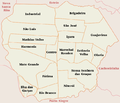Canoas
Canoas | |
|---|---|
Municipality | |
From top to bottom, left to right:
| |
|
UTC-2 (BRST) | |
| Website | canoas.rs.gov.br |
Canoas (Portuguese pronunciation:
Canoas is an industrial and educational hub, drawing residents from surrounding municipalities. It hosts a campus of the
Etymology
The city's name, Canoas, which means
History
The region that is now Canoas was originally inhabited by the Tapes
The construction of the railway in 1871 to connect São Leopoldo and Porto Alegre marked a pivotal development for the area. The establishment of a railway station in 1874 catalyzed the growth of the settlement that would become Canoas. The use of local timber for canoe making at the station helped name the area Capão das Canoas.
Significant growth continued into the 20th century with the arrival of the Lasallian brothers in 1908, who founded a school that offered agricultural, primary, and secondary education. The military also played a crucial role in the city's development, particularly with the establishment of the 3rd Military Aviation Regiment in 1937, which was instrumental in advocating for the city's emancipation. Canoas officially became a city in 1939 and continued to expand rapidly, especially from the 1970s onwards, establishing itself as a key economic player in the state.
Pictures of Canoas
-
Canoas subdivisions
-
Guajuviras neighbourhood
-
Canoas Air Base
-
Downtown Canoas
-
Getulio Vargas neighbourhood
-
Soccer game at theUlbraSport Club in the São José neighbourhood
-
UlbraUniversity
-
ULBRA Technological Museum
-
Chapel at the ULBRA
-
La Salle University
-
Old rail line in the Industrial neighbourhood
-
Gas station in the Igara neighbourhood
-
ZaffariBourbon grocery store in the Getulio Vargas neighbourhood
-
Cultural Foundation of Canoas in the historical train station building
-
BR-116 Federal Highway in Canoas
-
Urban Train that passes through Canoas
-
Canoas Intermunicipal Bus Station
-
Canoas Train Station in 1874
-
Main Catholic Church, 1931
-
Typical vegetation in Canoas
See also
External links
- Canoas Mayoral Office (in Portuguese)
- Satellite view of Canoas
- Images of the city and its History (in Portuguese) Images of homes are not representative of the rest of the city – the homes shown are part of one wealthy subdivision in the city
- SOGAL – Sociedade de Ônibus Gaúcha: Canoas City's Bus Transport (in Portuguese)
- ULBRA – Lutheran University of Brazil (in Portuguese)
References
- ^ "IBGE 2020". Archived from the original on 2021-01-30. Retrieved 2021-01-22.



























